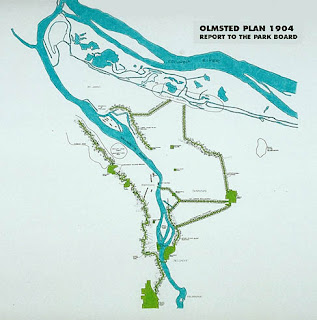Spaces like this are rare, they are works of art blending history and innovation--the essence of New Urbanism. The Pearl District is a model of New Urbanism http://www.pearldistrict.org/about-the-pearl-district/ Twenty years ago it was a decaying industrial district, now, with a 95 walk score, it is a prototype of the future.
Craig Ustler, the developer of Orlando's Creative Village, arguably the most promising urban infill project in Florida http://www.orlandosentinel.com/opinion/os-ed-racial-zoning-injustice-042415-20150423-story.html is a student of the Pearl District. It informs his plan to blend transit, parks, and mixed-use development to create a definitive urban neighborhood. Ustler http://www.ustler.net believes the intersection of Lovejoy and 10th Avenue, the site of Lovejoy Bakery, demonstrates "why Portland gets it." The lesson is not lost on my students, who study Portland with Mr. Ustler and then incorporate this knowledge into plans to form and activate Creative Village. https://dl.dropboxusercontent.com/u/29405235/CreativeVillageExec.pdf
Portland has invested in civic art for over a century. In 1904, the Olmsted Brothers prepared one of the nation's first plans for a park system in Portland. The idea of integrating a range of parks, from urban squares to large outlying preserves, was a novel concept. It set the foundation for American city planning profession, which came into fruition in the 1910s and 1920s, a "golden age" of civic design in the United States. Ladd's Addition, Laurelhurst Park, and Washington Park speak to this tradition.
Portland's history is not seamless, it is filled with fits and starts. It took nearly a century for the Olmsted Brothers Park Plan to reach completion. In 1939, another milestone was set when noted urbanist Lewis Mumford came west. In a presentation to the City Club, he declared Portlanders "could do a job of city planning like nowhere else in the world." But after seeing the neglect in "letting this fine land with its wonderful scenic beauty get away from you, it made me wonder if you are good enough to have it in your possession." Mumford deeded a regional plan to the city's leadership, but it was ignored until the early 1970s (the same time Walt Disney World opened) when a young cohort of reformers, led by Mayor Neil Goldschmidt, incorporated Mumford's major concepts. "Portland is a better place thanks in large part to the wisdom and foresight of Lewis Mumford," Goldschmidt noted in 1982. http://www.tandfonline.com/doi/abs/10.1080/01944369908976056
Portland is one of the nation's most sustainable cities because of its civic culture and its history. History provides a point of origin for citizens to join experts in tethering humanity's boundless potential to a set of time-tested principles and new ideas. This is the art of city planning and stay tuned for another exploration of its application in the Pearl District.



No comments:
Post a Comment